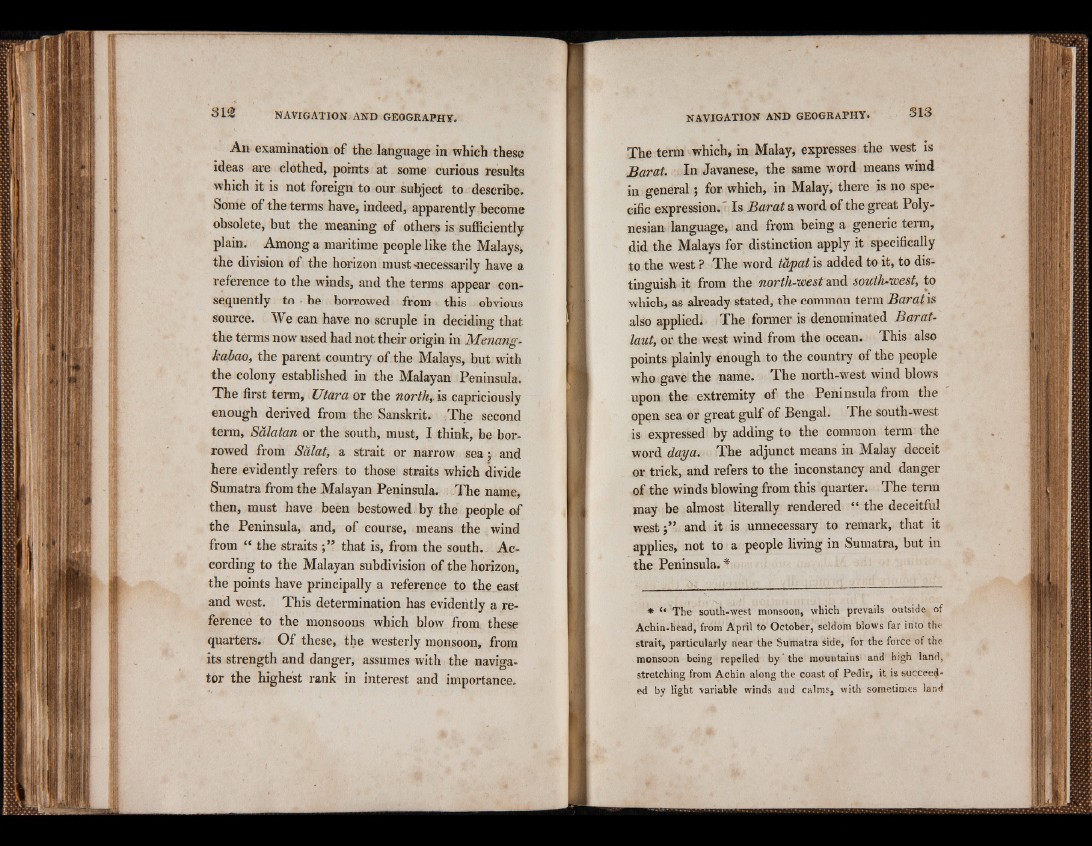
An examination of the language in which these
ideas are clothed, points at some curious results
which it is not foreign to our subject to describe.
Some of the terms have, indeed, apparently become
obsolete, but the meaning of others is sufficiently
plain. Among a maritime people like the Malays*
the division of the horizon must «necessarily have a
reference to the winds, and the terms appear consequently
to ■ be borrowed from this obvious
source. We can have no scruple in deciding that
the terms now used had not their origin in Menang-
kabao, the parent country of the Malays, but with
the colony established in the Malayan Peninsula.
The first term, ZJtara or the north,, is capriciously
enough derived from the Sanskrit. The second
term, Salatan or the south, must, I think, be borrowed
from Salat, a strait or narrow sea j and
here evidently refers to those straits which divide
Sumatra from the Malayan Peninsula. The name,
then, must have been bestowed by the people of
the Peninsula, and, of course, means the wind
from “ the straits that is, from the south. According
to the Malayan subdivision of the horizon,
the points have principally a reference to the east
and west. This determination has evidently a reference
to the monsoons which blow from these
quarters. Of these, the westerly monsoon, from
its strength and danger, assumes with the navigator
the highest rank in interest and importance.
The term which, in Malay, expresses the west is
jBar at. In Javanese, the same word means wind
in general; for which, in Malay, there is no specific
expression." Is Barat a word of the great Polynesian
language, and from being a generic term,
did the Malays for distinction apply it specifically
to the west ? The word tapat is added to it, to distinguish
it from the north-west and south-west, to o •.
which, as already stated, the common term Barat is
also applied* The former is denominated Barat-
laut, or the west wind from the ocean. This also
points plainly enough to the country of the people
who gave the name. The north-west wind blows
upon the extremity of the Peninsula from the
open sea or great gulf of Bengal. The south-west
is expressed by adding to the common term the
word day a. The adjunct means in Malay deceit
or trick, and refers to the inconstancy and danger
of the winds blowing from this quarter. The term
may be almost literally rendered “ the deceitful
west and it is unnecessary to remark, that it
applies, not to a people living in Sumatra, but in
the Peninsula. *
* The south-west monsoon, which prevails outside of
Achin-head, from April to October, seldom blows far into the
strait, particularly near the Sumatra side, for the force of the
monsoon being repelled by the mountains and high land,
stretching from Acbin along the coast of Pedir, it is succeeded
by light variable winds and calms, with sometimes land